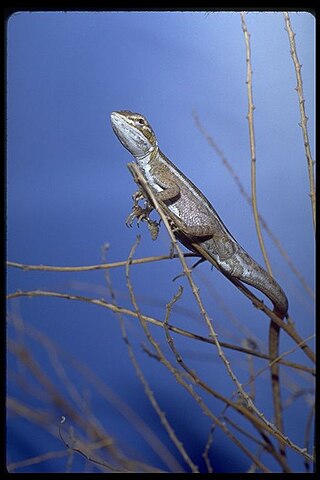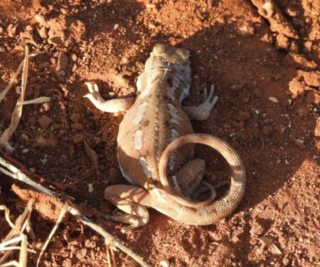The mulga dragon is a species of agamid lizard found in Western Australia. The species is up to 250 mm long, the length from snout to vent is 95 mm, with a long, slender tail that ends abruptly. The patterning over the legs and body is grey and brownish streaks. This provides an excellent camouflage on mulga trees, its usual habitat, it is also found beneath mulga leaf litter. Diporiphora amphiboluroides generally remains motionless and unobserved, this allows it to operate as an ambush predator and elude animals that would prey on it.

Ctenophorus is a genus of lizards, commonly known as comb-bearing dragons, found in Australia. They are in the dragon lizard family, known as Agamidae.

Diporiphora is a genus of lizards in the family Agamidae. Most species in the genus are endemic to Australia, but two are also found in New Guinea.

Tympanocryptis is a genus of Australian lizards in the family Agamidae, commonly known as earless dragons.

The thorny devil, also known commonly as the mountain devil, thorny lizard, thorny dragon, and moloch, is a species of lizard in the family Agamidae. The species is endemic to Australia. It is the sole species in the genus Moloch. It grows up to 21 cm (8.3 in) in total length, with females generally larger than males.

Draco blanfordii, commonly known as Blanford's flying dragon, Blanford’s flying lizard, or Blanford's gliding lizard, is a species of "flying" lizard in the family Agamidae. The species is endemic to Asia, and is capable of gliding from tree to tree.

Ctenophorus reticulatus, the western netted dragon or western netted ground-dragon, is a species of lizard in the family Agamidae. It is found in South Australia, Western Australia and southern Northern Territory.

Diporiphora winneckei, also known commonly as the canegrass dragon, canegrass two-line dragon, blue-lined dragon, and Winnecke's two-pored dragon, is a species of small, terrestrial, diurnal lizard in the family Agamidae. The species is endemic to Australia. It is found throughout arid zones of Australia and is also a common house pet.

Tympanocryptis tetraporophora, also known as Eyrean earless dragon or long-tailed earless dragon, is one of a documented species of a relatively small dragon belonging to the genus Tympanocryptis. Tympanocryptis is differentiated from other genera within the family Agamidae by a tympanum covered with scales and a missing phalange in the fifth toe of the rear foot. T. tetraporophora is a ground dwelling dragon inhabiting semi arid regions of central New South Wales, arid regions of South Australia, Northern Territory, Queensland and tropical grasslands of Northern Queensland.

Diplodactylus conspicillatus, also known commonly as the variable fat-tailed gecko or the burrow-plug gecko, is a species of lizard in the family Diplodactylidae. The species is endemic to Australia, where it is found in central and arid inland areas. Widespread across the continent, the variable fat-tailed gecko is most commonly found in sandy desert habitats dominated by spinifex grasses. It has also been bred in captivity by zoos and as pets.
The short-tailed striped gecko, also known commonly as McMillan's spiny-tailed gecko, is a species of lizard in the family Diplodactylidae. The species is endemic to Australia.

The Exmouth spiny-tailed gecko, also known commonly as Rankin's spiny-tailed gecko, is a species of lizard in the family Diplodactylidae. The species is endemic to Western Australia.
The gibber earless dragon also known as the smooth-snouted earless dragon, is a species of agamid lizard endemic to Australia. It is one of a documented species of the genus Tympanocryptis, a group of small terrestrial lizards that feed off invertebrates and are characterised by the absence of an external ear structure.

The Mallee dragon, also commonly known as the Mallee dragon and the Mallee sand-dragon, is a species of lizard in the family Agamidae. The species is native to the arid parts of southern Australia.
Ctenophorus clayi, also known commonly as the black-collared dragon, the black-shouldered ground-dragon, and Clay's dragon, is a species of lizard in the family Agamidae. The species is endemic to Australia.

Ctenophorus parviceps, commonly known as the Gnaraloo heath dragon or northwestern heath dragon is a species of agamid lizard occurring in pale coastal sands and shell grit with open heaths and beach spinifex, between the North West Cape and Carnarvon, Western Australia and on Bernier Island. The Gnaraloo heath dragon is a lizard that can be found along the coast of Western Australia between Exmouth Gulf and Shark Bay, and is also known as the northwestern heath dragon. It is native to Australia and usually inhabits sandy coastal dunes. The species' longevity is 3–50 years and its population density is extremely low. The Gnaraloo heath dragon is a member of the Agamidae family, which contains 15 genera. The lizard is under the Ctenophorus genus which has up to 33 species. This genus shows the most morphological and ecological diversity out of the three large agamid genera. 83% of the lizards in this genus lack a crest, while 17% possess crests. They are smaller than most agamids but do have relatively large heads. The Gnaraloo heath dragon can be differentiated from related species by a series of spines on the tail's base, a pale-grey brown broad vertebral band along its back, and hour-glass bars extending upwards to meet the pale vertebral band. It is usually 45mm in terms of length, measuring from snout to vent.

Tropicagama is a genus of large-bodied lizards in the family Agamidae. The genus is monotypic, with only one species listed: Tropicagama temporalis, commonly known as the swamplands lashtail or northern water dragon. This semi-arboreal species inhabits the tropical savannah woodlands of northern Australia, as well as parts of New Guinea and southeastern Indonesia.
Diporiphora bennettii, also known commonly as the Kimberley sandstone dragon or the robust two-line dragon, is a species of lizard in the family Agamidae. The species is endemic to Australia.

Diporiphora nobbi, also known commonly as the nobbi lashtail or the nobbi, is a species of lizard in the family Agamidae. The species is endemic to Australia.

Lophognathus gilberti, also known commonly as Gilbert's dragon, Gilbert's lashtail, or Ta-ta lizard, is a species of lizard in the family Agamidae. The species is endemic to Australia.
















